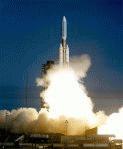
In late March, the American Geophysical Union announced that the Voyager I space probe became the first man-made object to leave our solar system. Just a few hours later though, NASA’s Jet Propulsion Laboratory shot down that claim noting that the tell-tale sign of hitting interstellar space (a “a change in the direction of the magnetic field”) hasn’t been detected yet.
Still, this whole thing got me thinking: NASA launched Voyager I in 1972 to peer more closely at the outer planets. By late 1980, the probe had completed its tour of Jupiter and Saturn and made a gravity-assisted beeline for the edge of the solar system. In the 40 or so years that Voyager has toured the outer fringes of the solar system, our focus on space has grown more limited, and in many ways it’s a new breed of space-based startups that are helping to spark imaginations the way NASA has done for decades.
You see, back on Earth, some people are looking to the heavens with renewed vigor — emphasis on “some.” There’s still plenty of work to be done in low Earth orbit, with SpaceX and a handful of other companies crafting and perfecting their cargo-ferrying space taxis for trips to the International Space Station. But the U.S. government’s drive to search out newer and farther frontiers in space has been seemingly tempered by political pragmatism and a dearth of available funds.
Ventures like Curiosity’s Mars landing were highlights in the history of space science and exploration, but these days NASA can’t even maintain its public outreach programs thanks to recent budget cuts.
That’s why the promise of privately operated space startups is so captivating: national priorities have shifted since the sixties, but that hasn’t kept some ambitious entrepreneurs from almost literally reaching for the stars. SpaceX founder Elon Musk famously noted that he hoped to establish a full-fledged colony on Mars, and at least one mildly kooky organization is looking to get people living and working on the Red Planet as soon as possible by way of a televised spectacle meant to raise funds and select the first batch of Martian astronauts. Mars isn’t the only floating hunk of rock that entrepreneurs are currently eying up, either. A startup called (unimaginatively enough) Planetary Resources has received backing from some serious names and aims to explore/hopefully mine nearby asteroids for precious materials with a fleet of specialized robots.
It’s not as though every space startup has ambitions as wild-eyed as those listed above. Altius Space Machines took home the top at NewSpace 2011′s business plan contest for its vision of simplifying the process of wrangling out-of-control satellites and the like. Meanwhile, SpaceGround Amalgam won that same prize a year later for its inflatable antenna concept — they fold up for easy storage during launch, and can inflate and harden once in orbit. These sorts of less-flashy startups are just as important as SpaceX and Planetary Resources — should their long term visions pan out, they could help lay the groundwork (spacework?) for more majestic, horizon-expanding ventures to come. Even the Startup Weekend guys are getting into it: the very first SW event dedicated solely to space is slated to kick off in late May with the goal of coaxing would-be space entrepreneurs into cooking up the next great space startup.
Some of the plans above sound like spurious tales of science fiction, pages ripped from a pulp novel, but they shouldn’t be immediately discounted just for that. I suppose the notion that a device of mankind’s creation would break free from the influence of the sun would’ve sounded like science fiction a few decades ago, so who’s to say what the next few years will bring.
Speaking of the next few years, Voyager doesn’t have much longer to live. At the probe’s current rate of power consumption, it has enough juice in its plutonium-powered generators to keep it going until about 2020, when NASA will begin to remotely shut down Voyager’s instruments one by one. Ultimately, Voyager will continue to drift in the sea of interstellar space, but humanity will lose contact with its most far-flung explorer in short order — here’s hoping that some savvy startups help to kick off a second Space Age before then.















